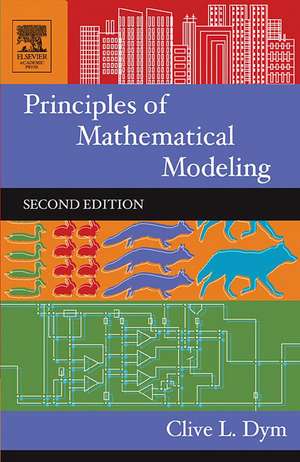Principles of Mathematical Modeling
Autor Clive Dymen Limba Engleză Hardback – 10 aug 2004
The first half of the book begins with a clearly defined set of modeling principles, and then introduces a set of foundational tools including dimensional analysis, scaling techniques, and approximation and validation techniques. The second half demonstrates the latest applications for these tools to a broad variety of subjects, including exponential growth and decay in fields ranging from biology to economics, traffic flow, free and forced vibration of mechanical and other systems, and optimization problems in biology, structures, and social decision making.
Prospective students should have already completed courses in elementary algebra, trigonometry, and first-year calculus and have some familiarity with differential equations and basic physics.
- Serves as an introductory text on the development and application of mathematical models
- Focuses on techniques of particular interest to engineers, scientists, and others who model continuous systems
- Offers more than 360 problems, providing ample opportunities for practice
- Covers a wide range of interdisciplinary topics--from engineering to economics to the sciences
- Uses straightforward language and explanations that make modeling easy to understand and apply
- A more systematic approach to mathematical modeling, outlining ten specific principles
- Expanded and reorganized chapters that flow in an increasing level of complexity
- Several new problems and updated applications
- Expanded figure captions that provide more information
- Improved accessibility and flexibility for teaching
Preț: 476.58 lei
Preț vechi: 584.30 lei
-18% Nou
Puncte Express: 715
Preț estimativ în valută:
91.19€ • 95.22$ • 75.30£
91.19€ • 95.22$ • 75.30£
Carte tipărită la comandă
Livrare economică 08-22 aprilie
Preluare comenzi: 021 569.72.76
Specificații
ISBN-13: 9780122265518
ISBN-10: 0122265513
Pagini: 303
Dimensiuni: 152 x 229 x 30 mm
Greutate: 0.52 kg
Ediția:Revised.
Editura: ELSEVIER SCIENCE
ISBN-10: 0122265513
Pagini: 303
Dimensiuni: 152 x 229 x 30 mm
Greutate: 0.52 kg
Ediția:Revised.
Editura: ELSEVIER SCIENCE
Public țintă
"Mathematical Modeling" courses typically taught in mathematics departments, but also occasionally in engineering schools.Cuprins
Part A: Foundations
1. What is Mathematical Modeling?
2. Dimensional Analysis
3. Scale
4. Approximating and Validating Models
Part B: Applications
5. Exponential Growth and Decay
6. Traffic Flow Models
7. Modeling Free Vibration
8. Applying Vibration Models
9. Optimization: What is the Best...?
1. What is Mathematical Modeling?
2. Dimensional Analysis
3. Scale
4. Approximating and Validating Models
Part B: Applications
5. Exponential Growth and Decay
6. Traffic Flow Models
7. Modeling Free Vibration
8. Applying Vibration Models
9. Optimization: What is the Best...?
Recenzii
"It is one of the best introductory texts in mathematical modeling which the reviewer warmly recommends to anyone who wishes to learn the foundations of mathematical modeling with enjoyment." --Yuri V. Rogovchenko, in ZENTRALBLATT FUR MATHEMATIK, 2005
"Principles of Mathematical Modeling is a delightfully readable, well-written account of the way engineers look at the world. It covers a surprizingly wide range of topics...The many examples treated in the text are drawn from the practical world that engineers inhabit, with some surprises thrown in for good measure..." --Robert Borelli, Harvey Mudd College
"The book itself is marvelously interdisciplinary, treating biological and human designed systems in addition to physical systems. These examples show that engineers can do more than simply analyze simple physical systems with known, exact solutions." --Bill Wood, University of Maryland at Baltimore
"Principles of Mathematical Modeling is a delightfully readable, well-written account of the way engineers look at the world. It covers a surprizingly wide range of topics...The many examples treated in the text are drawn from the practical world that engineers inhabit, with some surprises thrown in for good measure..." --Robert Borelli, Harvey Mudd College
"The book itself is marvelously interdisciplinary, treating biological and human designed systems in addition to physical systems. These examples show that engineers can do more than simply analyze simple physical systems with known, exact solutions." --Bill Wood, University of Maryland at Baltimore


















